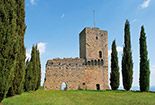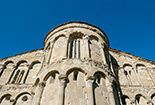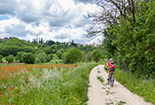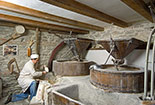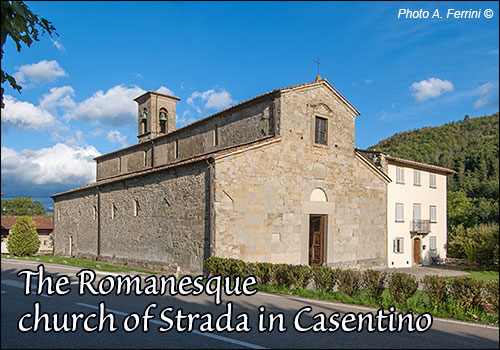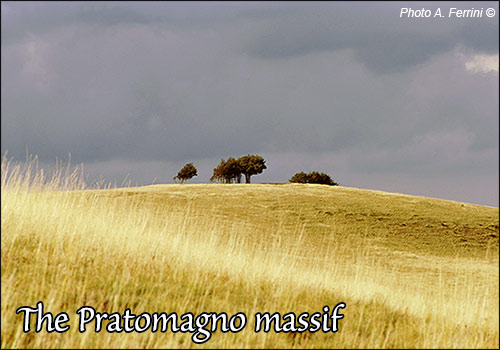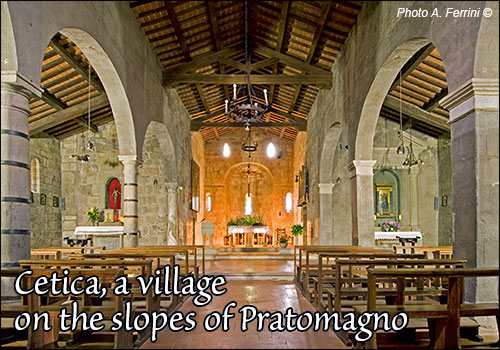The municipal territory of Castel San Niccolò
the Casentino, a Tuscan valley with which you can get familiar in every detail through this site
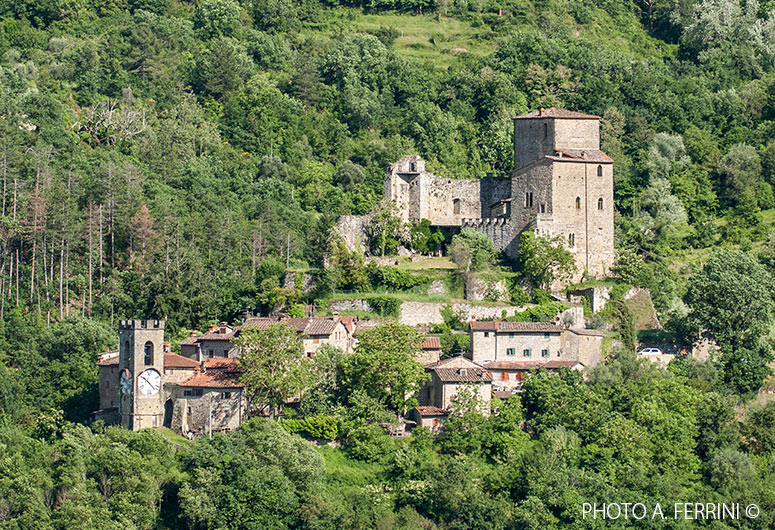
Texts and photos by Alessandro Ferrini ©
110 images in sequence with captions for a virtual journey in the municipal area of Castel San Niccolò.
A virtual journey in the territory of Castel San Niccolò
 Arriving in Strada in Casentino da Poppi, at the beginning of the town we are welcomed by the Pieve di San Martino a Vado, one of the most important medieval monuments in the valley. This church, built in the sixth decade of the twelfth century, was commissioned by the Counts Guidi who dominated this area from the overhanging Castle of San Niccolò. According to a widespread legend, the construction of this Romanesque church, as well as others in the Casentino and Valdarno, is due to the will of the Countess Matilde of Canossa who left a large sum of money for this purpose upon her death (1115). The Pieve di San Martino a Vado, better known as Pieve di Strada, is worth visiting for its fascinating architecture enriched with beautiful capitals that show us a variety of motifs. In addition, it is a place of art, here we can admire fourteenth-century frescoes from the castle chapel and other paintings from the sixteenth and seventeenth centuries.
Castel San Niccolò is located on a rocky spur on the hill to the right of the Solano stream. It was one of the most important castles of the Guidi. Little is known of its origin, however it should have been built in the second half of the 12th century. Instead, a change of ownership in 1253 is well documented when it passed from Count Guido Novello to Guido Novello di Modigliana, thus remaining within the same family. From the opposite hill, you can get an interesting overall view of the castle that makes it possible to see what is left of it and imagine what its architecture used to be in the Middle Ages. This ancient place can be easily reached by car, but it is also possible to walk there in 15 minutes through a stairway from the center of Strada up to the bridge that crosses the torrent Solano. The ancient path that leads to the castle starts on the left side of the torrent, right under the great clock tower. There is a beautiful door with pointed arch beside it. Beyond it, on the right, there is a building with slit windows. It was the church dedicated to San Niccolò. A few meters forward, an ancient building shows an elegant architrave above the front door with three crests carved. In the period of the Florentine dominion, this building was the Podesteria palace until 1776, when it was moved to Strada. Beyond it, there is a chapel with crests on its facade. On the inside, it is stored a 1439 fresco of a crucifix. This irregularly shaped building was originally the castle prison.
During the whole visit, you will be dominated by a great building on the top of the hill. It used to be the residential part of the Guidi castle, which was renovated during the Florentine Republic time (1349). On a double-lancet window, the “Arte della Lana” crest is carved. Castel San Niccolò is the starting point of a beautiful path through the woods that leads to Quorle, a small town in the Municipality of Poppi.
Arriving in Strada in Casentino da Poppi, at the beginning of the town we are welcomed by the Pieve di San Martino a Vado, one of the most important medieval monuments in the valley. This church, built in the sixth decade of the twelfth century, was commissioned by the Counts Guidi who dominated this area from the overhanging Castle of San Niccolò. According to a widespread legend, the construction of this Romanesque church, as well as others in the Casentino and Valdarno, is due to the will of the Countess Matilde of Canossa who left a large sum of money for this purpose upon her death (1115). The Pieve di San Martino a Vado, better known as Pieve di Strada, is worth visiting for its fascinating architecture enriched with beautiful capitals that show us a variety of motifs. In addition, it is a place of art, here we can admire fourteenth-century frescoes from the castle chapel and other paintings from the sixteenth and seventeenth centuries.
Castel San Niccolò is located on a rocky spur on the hill to the right of the Solano stream. It was one of the most important castles of the Guidi. Little is known of its origin, however it should have been built in the second half of the 12th century. Instead, a change of ownership in 1253 is well documented when it passed from Count Guido Novello to Guido Novello di Modigliana, thus remaining within the same family. From the opposite hill, you can get an interesting overall view of the castle that makes it possible to see what is left of it and imagine what its architecture used to be in the Middle Ages. This ancient place can be easily reached by car, but it is also possible to walk there in 15 minutes through a stairway from the center of Strada up to the bridge that crosses the torrent Solano. The ancient path that leads to the castle starts on the left side of the torrent, right under the great clock tower. There is a beautiful door with pointed arch beside it. Beyond it, on the right, there is a building with slit windows. It was the church dedicated to San Niccolò. A few meters forward, an ancient building shows an elegant architrave above the front door with three crests carved. In the period of the Florentine dominion, this building was the Podesteria palace until 1776, when it was moved to Strada. Beyond it, there is a chapel with crests on its facade. On the inside, it is stored a 1439 fresco of a crucifix. This irregularly shaped building was originally the castle prison.
During the whole visit, you will be dominated by a great building on the top of the hill. It used to be the residential part of the Guidi castle, which was renovated during the Florentine Republic time (1349). On a double-lancet window, the “Arte della Lana” crest is carved. Castel San Niccolò is the starting point of a beautiful path through the woods that leads to Quorle, a small town in the Municipality of Poppi.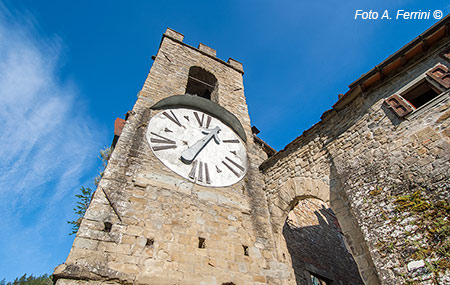 As already mentioned, the village of Strada in Casentino (originally Borgo alla Strada, opposed to Borgo alla Collina which we will talk about later) has its origins in an important market place born in an unidentified time, but already known in the 14th century.Markets, in that time, were born spontaneously wherever there was transit of people, clearly authorized by the lords of that place; in this case, the Counts Guidi, masters of the San Niccolò Castle. Here, two important roads that guaranteed the transit of wayfarers, pilgrims and merchants met. One of these roads was Via delle Pievi that, from upper Casentino reached Arezzo along the river Arno’s left side; the other one climbed the Solano valley up and then divided into three branches that crossed Pratomagno – to reach Valdarno – Varco della Vetrice, Gastra and Reggello. These routes still exist as CAI paths.
Another fundamental element near a market was a church, and it was built in the early 11th century by the name Church of San Martino in Terdinula. The church was later replaced in the mid-12th century with the Church of San Martino a Vado that we can still see today in the original dimension and shape.
The most interesting part of Strada in Casentino is the central Matteotti square. This square was also the “heart” of the ancient market. The big porticoes – called “Del Grano” – were built in order to make trade possible even with bad weather. In 1776, the elegant palace nearby the porti- coes – the current Comunal Library – became the new Podesteria Palace for the will of the Grand Duke Peter Leopold, which used to be in San Niccolò Castle. Other elegant palaces characterize Matteotti square.
As already mentioned, the village of Strada in Casentino (originally Borgo alla Strada, opposed to Borgo alla Collina which we will talk about later) has its origins in an important market place born in an unidentified time, but already known in the 14th century.Markets, in that time, were born spontaneously wherever there was transit of people, clearly authorized by the lords of that place; in this case, the Counts Guidi, masters of the San Niccolò Castle. Here, two important roads that guaranteed the transit of wayfarers, pilgrims and merchants met. One of these roads was Via delle Pievi that, from upper Casentino reached Arezzo along the river Arno’s left side; the other one climbed the Solano valley up and then divided into three branches that crossed Pratomagno – to reach Valdarno – Varco della Vetrice, Gastra and Reggello. These routes still exist as CAI paths.
Another fundamental element near a market was a church, and it was built in the early 11th century by the name Church of San Martino in Terdinula. The church was later replaced in the mid-12th century with the Church of San Martino a Vado that we can still see today in the original dimension and shape.
The most interesting part of Strada in Casentino is the central Matteotti square. This square was also the “heart” of the ancient market. The big porticoes – called “Del Grano” – were built in order to make trade possible even with bad weather. In 1776, the elegant palace nearby the porti- coes – the current Comunal Library – became the new Podesteria Palace for the will of the Grand Duke Peter Leopold, which used to be in San Niccolò Castle. Other elegant palaces characterize Matteotti square.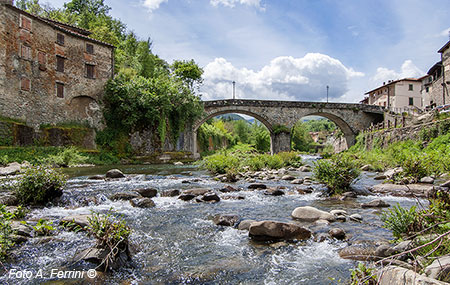 The Oratorio delle Visitazione dates back to the 16th century, and it was built in a corner of the square in order to provide a convenient place of worship for the people who went to the market and also for those who lived in that area and could not reach the far away San Martino Church. Although architecturally simple, the oratory is very interesting for the art stored there. In particular two artworks: one board by Santi di Tito of the 1580s representing the Coronation of the Immaculate between the Saints Giovanni Battista e Francis and a 1650 oil on canvas where the painter Giovanni Francesco Guerrieri represented the Virgin showing the Child during the apparition to Saint Anthony of Padua.
In Casentino, speaking of Strada, one immediately thinks of stone. The reason is simple: for centuries this place has been the reference point in the valley for stone processing. Some families of this country have been carrying on the craft of the stonemason for many generations, a job that is halfway between art and crafts. As a reminder of this ancient tradition, there are two exhibitions in the town. One, more artistic, is located at the entrance to the historic center, a few steps from Piazza Matteotti. There are many works on display that refer to the figure of St. Francis. The second exhibition is part of the Casentino Ecomuseum. Here, in addition to being exhibited various works of a more artisanal nature, the history and working tools of this ancient craft are shown and described. The museum is located in the so-called Seminario di Strada, a huge villa built in the mid-eighteenth century by the spouses Domenico Gatteschi and Lucrezia Tommasi. At the beginning of the nineteenth century, the huge building was left to the Diocese of Fiesole who set up an ecclesiastical college and a small seminary dependent on that of Fiesole. The villa is located on the hill opposite the Castle of San Niccolò. It offers us a beautiful view of this and the country. We can get there, on foot or by car, with a short climb that starts from Strada.
Almost attached to this town, towards the south-west, is Prato di Strada. A place of ancient origin, it was known for the presence of artisans dedicated to the creation of the shoes that went to sell in the various markets of the Casentino. From here a road starts which, after crossing the Solano stream, leads us to the towns of Spalanni and Garliano. Then it continues towards Pratomagno (better to tackle it with a 4x4 car).
In the opposite direction, less than two kilometers from Strada in Casentino, is Borgo alla Collina. The place is quite well known for logistical reasons because it is crossed by the road that leads to the Passo della Consuma, which is the most important link between Florence and the Casentino. The name already tells us a lot about its geographical location, in fact it is located at the top of a hill from which you can see both the Arno and the Solano valleys. This is the reason why in the 12th century the Guidi Counts also built a castle here. In the church of Borgo alla Collina there is a refined triptych with a gold background showing the mystical marriage of Saint Catherine. From this inhabited area a path starts which, passing next to the Orgi Oratory, in about a kilometer leads to the Arno. Near the river, towards the north, we have a beautiful view of the Castle of Romena.
In the municipal area of Castel San Niccolò there are many small villages unknown to most people, yet witnesses of an ancient and important
The Oratorio delle Visitazione dates back to the 16th century, and it was built in a corner of the square in order to provide a convenient place of worship for the people who went to the market and also for those who lived in that area and could not reach the far away San Martino Church. Although architecturally simple, the oratory is very interesting for the art stored there. In particular two artworks: one board by Santi di Tito of the 1580s representing the Coronation of the Immaculate between the Saints Giovanni Battista e Francis and a 1650 oil on canvas where the painter Giovanni Francesco Guerrieri represented the Virgin showing the Child during the apparition to Saint Anthony of Padua.
In Casentino, speaking of Strada, one immediately thinks of stone. The reason is simple: for centuries this place has been the reference point in the valley for stone processing. Some families of this country have been carrying on the craft of the stonemason for many generations, a job that is halfway between art and crafts. As a reminder of this ancient tradition, there are two exhibitions in the town. One, more artistic, is located at the entrance to the historic center, a few steps from Piazza Matteotti. There are many works on display that refer to the figure of St. Francis. The second exhibition is part of the Casentino Ecomuseum. Here, in addition to being exhibited various works of a more artisanal nature, the history and working tools of this ancient craft are shown and described. The museum is located in the so-called Seminario di Strada, a huge villa built in the mid-eighteenth century by the spouses Domenico Gatteschi and Lucrezia Tommasi. At the beginning of the nineteenth century, the huge building was left to the Diocese of Fiesole who set up an ecclesiastical college and a small seminary dependent on that of Fiesole. The villa is located on the hill opposite the Castle of San Niccolò. It offers us a beautiful view of this and the country. We can get there, on foot or by car, with a short climb that starts from Strada.
Almost attached to this town, towards the south-west, is Prato di Strada. A place of ancient origin, it was known for the presence of artisans dedicated to the creation of the shoes that went to sell in the various markets of the Casentino. From here a road starts which, after crossing the Solano stream, leads us to the towns of Spalanni and Garliano. Then it continues towards Pratomagno (better to tackle it with a 4x4 car).
In the opposite direction, less than two kilometers from Strada in Casentino, is Borgo alla Collina. The place is quite well known for logistical reasons because it is crossed by the road that leads to the Passo della Consuma, which is the most important link between Florence and the Casentino. The name already tells us a lot about its geographical location, in fact it is located at the top of a hill from which you can see both the Arno and the Solano valleys. This is the reason why in the 12th century the Guidi Counts also built a castle here. In the church of Borgo alla Collina there is a refined triptych with a gold background showing the mystical marriage of Saint Catherine. From this inhabited area a path starts which, passing next to the Orgi Oratory, in about a kilometer leads to the Arno. Near the river, towards the north, we have a beautiful view of the Castle of Romena.
In the municipal area of Castel San Niccolò there are many small villages unknown to most people, yet witnesses of an ancient and important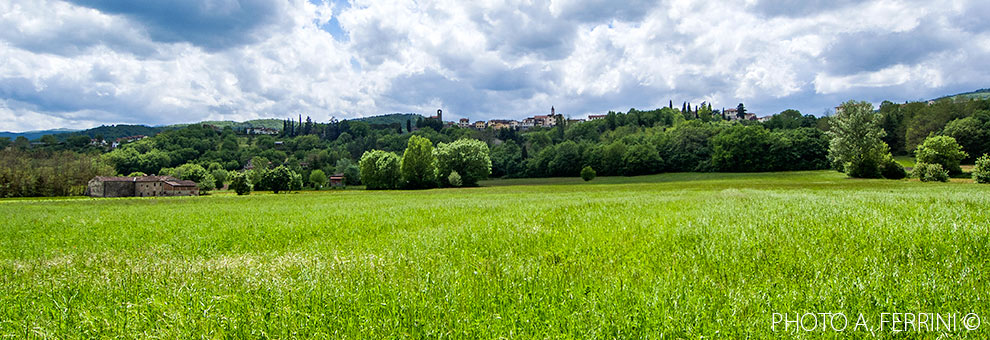 history. We have already mentioned two of them (Spalanni, Garliano), others to remember are Rifiglio, Battifolle, Ristonchi, Caiano, Vertelli, Pagliericcio, Cetica, Terzelli, Torre, Tartiglia. Often these settlements are connected to each other by ancient paths. We will know them virtually by scrolling through the pages of this web section. They will be presented to us by their churches, buildings still grateful to tell the past of these places.
history. We have already mentioned two of them (Spalanni, Garliano), others to remember are Rifiglio, Battifolle, Ristonchi, Caiano, Vertelli, Pagliericcio, Cetica, Terzelli, Torre, Tartiglia. Often these settlements are connected to each other by ancient paths. We will know them virtually by scrolling through the pages of this web section. They will be presented to us by their churches, buildings still grateful to tell the past of these places.



